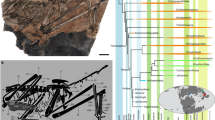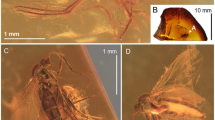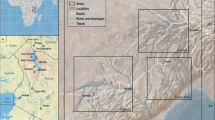Abstract
The origin of the most diverse terrestrial animal group, Atelocerata (myriapods and hexapods), is obscured by an incomplete fossil record1. Early (Silurian and Devonian) body fossils of terrestrial arthropods have been found only in Laurussia, with key sites in Britain and eastern North America2,3,4,5. Although trace fossil assemblages indicate the presence of various arthropods on land in Australia in the Silurian Period6, definite terrestrial arthropods have not been discovered in mid-Palaeozoic stages of the southern continents. Here I describe the first atelocerates from the Devonian stages of Gondwana; these are perhaps the earliest known remains of Australian land animals. The fossils comprise two closely related myriapod species of the genus Maldybulakia, first identified from Kazakhstan7,8. They add substantially to our knowledge of the anatomy of this problematic arthropod, and illustrate the widespread distribution of parts of the Devonian terrestrial fauna. A clade including Maldybulakia is distinct within the Myriapoda at a high taxonomic level. The existence of Maldybulakia and the extinct classes Arthropleuridea and Kampecarida9, with centipedes and millipedes, indicates the high class-level diversity of myriapods in the Devonian.
This is a preview of subscription content, access via your institution
Access options
Subscribe to this journal
Receive 51 print issues and online access
$199.00 per year
only $3.90 per issue
Buy this article
- Purchase on Springer Link
- Instant access to full article PDF
Prices may be subject to local taxes which are calculated during checkout


Similar content being viewed by others
References
Rolfe, W. D. I. Early terrestrial arthropods: a fragmentary record. Phil. Trans. R. Soc. Lond. B 309, 207–218 (1985).
Almond, J. E. The Silurian-Devonian fossil record of the Myriapoda. Phil. Trans. R. Soc. Lond. B 309, 227–237 (1985).
Jeram, A. J., Selden, P. A. & Edwards, D. Land animals in the Silurian: arachnids and myriapods from Shropshire, England. Science 250, 658–661 (1990).
Shear, W. A. in Arthropod Paleobiology. Short Courses in Paleontology 3 (ed. Mikulic, D. G.) 197–213 (Paleontol. Soc., Knoxville, (1990)).
Shear, W. A., Gensel, P. G. & Jeram, A. J. Fossils of large terrestrial arthropods from the Lower Devonian of Canada. Nature 384, 555–557 (1996).
Trewin, N. H. & McNamara, K. J. Arthropods invade the land: trace fossils and palaeoenvironments of the Tumblagooda Sandstone (?late Silurian) of Kalbarri, Western Australia. Trans. R. Soc. Edinb. Earth Sci. 85, 177–210 (1995).
Tesakov, A. S. & Alekseev, A. S. Myriapod-like arthropods from the Lower Devonian of central Kazakhstan. Paleontol. J. 26, 18–23 (1992).
Tesakov, A. S. & Alekseev, A. S. Maldybulakia—new name for Lophodesmus Tesakov & Alekseev, 1992 (Arthropoda). Paleontol. J. 32, 49 (1998).
Shear, W. A. in Arthropod Relationships (eds Fortey, R. A. & Thomas, R. H.) 211–219 (Chapman & Hall, London, (1997)).
Owen, M. & Wyborn, D. Geology and geochemistry of the Tantangara and Brindabella area. Bull. Bur. Miner. Resour. Geol. Geophys. Aust. 204((1979)).
Fergusson, C. L. et al. The Upper Devonian Boyd Volcanic Complex, Eden, New South Wales. J. Geol. Soc. Aust. 26, 87–105 (1979).
Regier, J. C. & Shultz, J. W. Molecular phylogeny of the major arthropod groups indicates polyphyly of crustaceans and a new hypothesis for the origin of hexapods. Mol. Biol. Evol. 14, 902–913 (1997).
Zrzavý, J., Hypša, V. & Vlášková, M. in Arthropod Relationships (eds Fortey, R. A. & Thomas, R. H.) 97–107 (Chapman & Hall, London, (1997).
Kraus, O. in Arthropod Relationships (eds Fortey, R. A. & Thomas, R. H.) 295–303 (Chapman & Hall, London, (1997)).
Wheeler, W. C., Cartwright, P. & Hayashi, C. Y. Arthropod phylogeny: a combined approach. Cladistics 9, 1–39 (1993).
Ballard, J. W. et al. Evidence from 12S ribosomal RNA sequences that onychophorans are modified arthropods. Science 258, 1345–1348 (1992).
Friedrich, M. & Tautz, D. Ribosomal DNA phylogeny of the major extant arthropod classes and the evolution of myriapods. Nature 376, 165–167 (1995).
Wägele, J. W. & Stanjek, G. Arthropod phylogeny inferred from partial 12SrRNA revisited: monophyly of the Tracheata depends on sequence alignment. J. Zool. Syst. Evol. Res. 33, 75–80 (1995).
Wheeler, W. C. in Arthropod Fossils and Phylogeny (ed. Edgecombe, G. D.) 9–32 (Columbia Univ. Press, New York, (1998).
Manton, S. M. in Myriapod Biology (ed. Camatini, M.) 317–343 (Academic, London, (1979).
Almond, J. E. Studies on Palaeozoic Arthropoda. Thesis, Univ. Cambridge((1986)).
Shear, W. A. & Selden, P. Eoarthropleura (Arthropoda, Arthropleurida) from the Silurian of Britain and the Devonian of North America. Neues. Jb. Geol. Palaeontol. Abh. 196, 347–375 (1995).
Schneider, J. Environment, biotas and taphonomy of the Lower Permian lacustrine Neiderhäslich limestone, Döhlen Basin, Germany. Trans. R. Soc. Edinb. Earth Sci. 84, 453–464 (1994).
McNamara, K. J. & Trewin, N. H. Aeuthycarcinoid arthropod from the Silurian of Western Australia. Palaeontology 36, 319–335 (1993).
Scotese, C. R. & McKerrow, W. S. in Palaeozoic Paleogeography and Biogeography (eds McKerrow, W. S. & Scotese, C. R.) 1–21 (Geol. Soc. Lond., (1990)).
Li, Z.-X., Powell, C. M. & Trench, A. in Palaeozoic Vertebrate Biostratigraphy and Biogeography (ed. Long, J. A.) 25–53 (Belhaven, London, (1993)).
Acknowledgements
I thank K. S. W. Campbell and A. Ritchie for showing me the fossil sites; Z. Johanson, B. Loomes, Y.-y. Zhen and volunteers organized by M. Yeung for assistance in collecting fossils; and D. E. G. Briggs, J. A. Dunlop, W. A. Shear, and G. D. F. Wilson for comments. NSW State Forests permitted collecting. A grant from Australian Geographic supported fieldwork.
Author information
Authors and Affiliations
Corresponding author
Rights and permissions
About this article
Cite this article
Edgecombe, G. Devonian terrestrial arthropods from Gondwana. Nature 394, 172–175 (1998). https://doi.org/10.1038/28156
Received:
Accepted:
Published:
Issue Date:
DOI: https://doi.org/10.1038/28156
This article is cited by
-
Rediscovery of the world's leggiest animal
Nature (2006)
-
Preserved organs of Devonian harvestmen
Nature (2003)
-
Ancient Australian arthropods
Nature (1998)
Comments
By submitting a comment you agree to abide by our Terms and Community Guidelines. If you find something abusive or that does not comply with our terms or guidelines please flag it as inappropriate.



